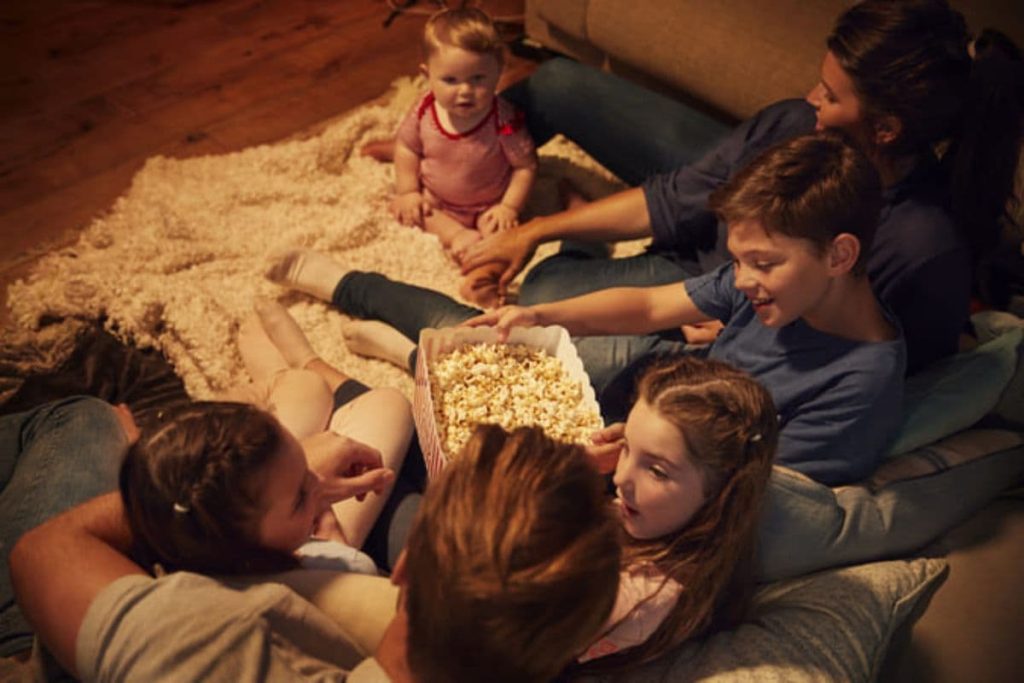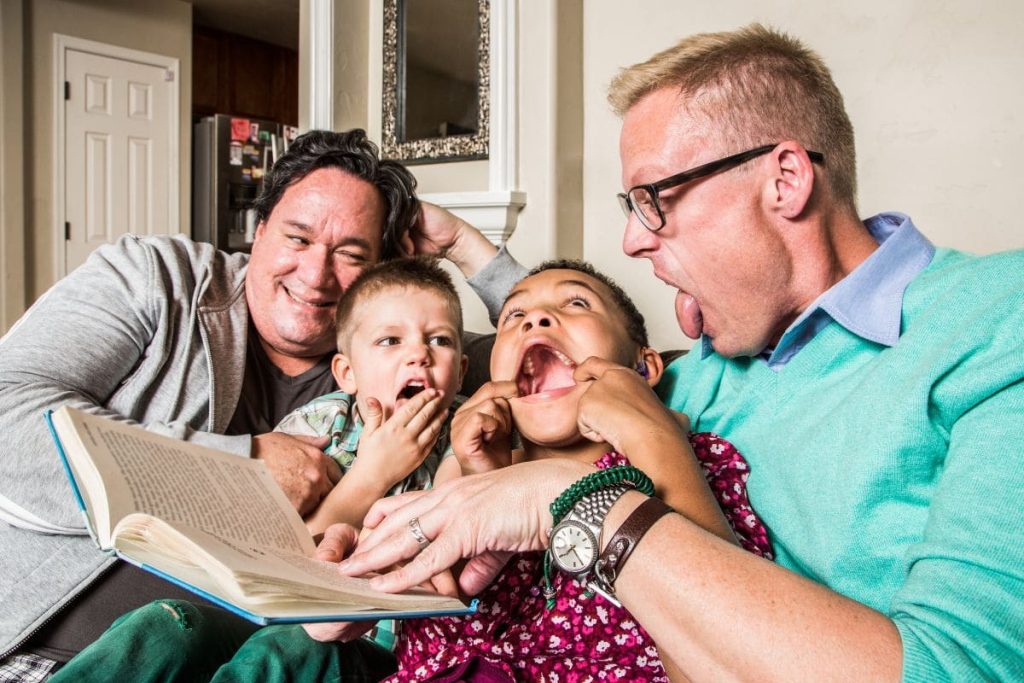The nuclear family has been a common family structure in many cultures throughout history. Nowadays, they play a significant role in modern society. Traditionally characterized as a two-parent nuclear family, this model often stands in contrast to extended families. As we examine these nuclear family households, we will gain insights into how each individual’s own family experience shapes their understanding in modern times.
Key Takeaways:
- The traditional nuclear family consists of parents and children living under one roof. Yet, its definition has expanded in today’s society.
- Nuclear families offer advantages such as stability and emotional support. But they also face challenges related to joint and extended family structures, as well as evolving family ties.
- The concept of a nuclear family is influenced by cultural and societal changes, which will continue to shape its future.
What is a Nuclear Family
Historical Context
The nuclear family, an elementary or conjugal family, has been a prevalent social unit throughout history. It consists of two adults and their children living together in one residence. This historical context supports the idea that this family system was the most favorable way to raise children.
Historically, this family household is considered the family of procreation, specifically because children are born and raised within the nuclear family.
Modern Interpretations
The nuclear family concept may have evolved in today’s increasingly diverse society. However, it remains an integral part of our culture. Modern interpretations of the term have expanded for various types of families. Oftentimes, it extends beyond the traditional structure of one man and one woman.
Today, nuclear families may include extended family members, detached nuclear families, same-sex parents or even single parents raising their children.
- Elementary family: Same as traditional nuclear family (parents and children).
- Conjugal family: Emphasizes the marital relationship as the basis of the family unit.
- Family of procreation: A family that comes into existence with the birth of children.
- Immediate family: Includes parents and children, sometimes expanded to include the closest relatives (e.g., grandparents, siblings).
Components of a Nuclear Family
Parental Roles
In a nuclear family, the parents play a crucial role in raising and nurturing their children. Typically, this family category consists of a mother and a father who are married or in a committed partnership.
They work together to provide a stable environment for their children, ensuring they meet the basic needs of their own family. This includes food, shelter, and emotional support.
Mother’s Role: The mother often takes on responsibilities such as nurturing and caring for the children. They mostly provide emotional support and manage daily household tasks.
Father’s Role: A father primarily focuses on providing for the family financially offering guidance and discipline. They also engage in leisure activities with the children.
However, it’s important to note that the roles of these two parents are not set in stone. In most cases, modern nuclear families and detached nuclear families often see both parents sharing duties and responsibilities interchangeably.
Children’s Roles
The children within a nuclear family play an essential part in the family dynamics as well. This includes sons and daughters with different experiences and responsibilities within the family structure.
Here are some typical roles children can have within a nuclear family:
- Helper: Many children assist their parents with household chores and tasks, learning responsibility and contributing to the family’s overall function.
- Student: Children are often expected to excel in their studies and extracurricular activities as they learn and grow.
- Sibling relationships: Interaction between siblings can significantly shape a child’s social skills, sense of responsibility, and emotional development. Sons and daughters often learn from each other and provide support and companionship.
Nuclear Family and Society

Societal Expectations
In sociology, the nuclear family, consisting of married parents and their children, has often been considered the cornerstone of society, especially in an American nuclear family. Societal expectations have long revolved around this concept, with the idea that a stable, traditional family unit contributes to more prosperous societies.
For instance, financial stability, housing arrangements, and socializing priorities are generally designed with this family model in mind.
The nuclear family has implications for the development of social groups within communities even for young parents. Schools, religious organizations, and extracurricular activities often emphasize the participation of entire families, catering to nuclear family structures. These family forms are seen in many societies, though the prominence of the nuclear family varies across cultures and the past half-century.
Impact on Community
A single nuclear family or two nuclear families can help shape the foundation of communities, influencing social dynamics in various ways:
- Economic Stability: Nuclear families tend to be financially stable, given the pooled incomes of both parents, contributing to thriving neighborhoods and communities.
- Social Bonds: The traditional nuclear family model often fosters stronger neighborhood connections, forming supportive networks and friendships.
- Sense of Community: Strong nuclear family representations promote a cohesive environment where families work together towards shared goals and mutual support.
However, the focus on nuclear family structures can marginalize other types of families, such as single-parent households, same-sex couples, multi-generational families and extended family members potentially leaving these groups feeling unsupported or isolated.
As the family landscape evolves, communities should adapt to be more inclusive, understanding that there are different types of families, where two parents are capable of contributing to a healthy community.
Variations and Evolutions

In today’s modern society, the concept of a nuclear family continues to evolve and adapt to encompass various family structures and situations.
It’s essential to recognize the different variations of nuclear families that may come into existence through adoption, blended families, single-parent households, and LGBTQ+ households.
Here’s a quick table overview:
| Family Type | How Society Accepts Them | Challenges | Advantages |
|---|---|---|---|
| Adoption | Generally positive, but can involve misconceptions about adoptive families. | Navigating the adoption process. Integrating the child into the family. | Provides a loving home for a child in need. Enriches family diversity. |
| Blended Families | Increasing acceptance as blended families become more common. | Adjusting to new family dynamics. Managing relationships between step-siblings and step-parents. | Opportunity to form new familial bonds. Broadens familial experiences. |
| Single-Parent Households | Widely accepted, though single parents may face stigmatization. | Economic and emotional challenges of single-handedly raising children. Balancing work and parenting responsibilities. | Strong parent-child bond. Independence and resilience in parenting. |
| LGBTQ+ Households | Growing acceptance, particularly in urban and progressive areas, but still faces significant societal challenges. | Potential societal discrimination. Legal challenges in some regions. | Promotes inclusivity and diversity. Strengthens advocacy and community ties. |
Adoption and Blended Families
Adopted children have become a common aspect of the nuclear family, as many married parents choose to expand their families by welcoming children from different backgrounds and circumstances. These families still maintain the essential structure of a nuclear family but may consist of both biological and adopted children.
Blended families are another increasingly common variation, formed when two previously separate family units come together after the parents enter a new partnership or marriage.
This union, even for young parents, often results in a mix of biological parents and step-children living under one roof, forming a unique and diverse nuclear family.
Single-parent and LGBTQ+ Households
Single-parent families significantly depart from the traditional nuclear family structure, with one parent taking on the primary responsibility for raising the children. These households face unique challenges and experiences but still contribute to the diverse understanding of family dynamics.
With the increasing acceptance and recognition of LGBTQ+ relationships and same-sex marriage, many nuclear families now consist of parents from diverse gender and sexual identities. Based on family studies, these couples may have children through:
- Adoption
- Surrogacy
- Previous heterosexual relationship
Comparison with Extended Family

Cultural Differences
In many cultures, extended family plays a significant role in the lives of individuals. This family structure often includes closely related relatives like grandparents, aunts, uncles, and cousins, living together.
While the nuclear family typically consists of married parents and their children, the extended family provides a broader support network, which can influence the upbringing and socialization of the children within the family unit.
As you can see, the difference in family structures can greatly affect the way an individual values family relationships and interacts with their relatives.
Support Systems
| Family Type | Key Support Examples |
|---|---|
| Nuclear Family | Parental guidance, sibling relationships |
| Extended Family | Emotional, financial, and practical support from multiple family members |
One of the main differences between nuclear and extended families is the support system available to family members. A nuclear family usually relies on the parents for guidance, emotional support, and financial assistance. Siblings may also play a role in providing friendship and camaraderie.
In contrast, extended families offer a wider range of support options, with relatives like grandparents and aunts often stepping in to offer emotional support, childcare, or financial assistance when needed. This can provide a safety net for family members, enabling them to weather difficult situations more effectively.
Good To Know: In some cultures, the importance of extended family cannot be understated. The involvement of extended family members in the lives of the children can help create strong family bonds and foster a sense of community.
Functional Dynamics

Economic Cooperation
A nuclear family typically consists of two generations:
- Parents
- Children living together under one roof
This family unit plays a crucial role in the household economy. Family members usually share expenses, resources, and financial responsibilities, providing a sense of security for everyone involved.
In a nuclear family, members usually contribute to financial stability based on their abilities and roles. Parents often have jobs outside the home, generating income for the family, while children may have chores, gradually learning responsibility and the importance of contributing to the household.
Emotional Support
Emotional support is another vital aspect of functional dynamics in a nuclear family. The bonds and relationships between family members provide a strong foundation for love, trust, and care.
On Guidance and Love
Parents guide and nurture their children, helping them develop and grow in a safe, supportive environment. The close-knit relationships within the family enable open communication, expression of feelings, and mutual understanding. These elements contribute to emotional stability and the well-being of each family member.
In addition to emotional support, love plays a central role in the emotional dynamics of a nuclear family, creating the basis for the development of healthy relationships not just within the family but also in social interactions outside the home.
Challenges and Criticisms
Stereotypes and Pressure
The concept of a nuclear family, which consists of a mother, father, and children living together, often perpetuates societal norms and expectations. These pressures can create a sense of obligation to fulfill specific roles within the family structure.
For instance, mothers may need to stay home and care for their children while fathers are pressured to be the primary breadwinners.
However, not all families fit the traditional mold of a nuclear family. Single-parent households, alternative family structures, and diverse reproductive options challenge these outdated norms. As society evolves, it is important to recognize and accept various family arrangements and understand their unique challenges.
Modern Challenges
Mental Health
Mental health is a significant concern in today’s fast-paced world. The pressures associated with the nuclear family can contribute to stress, anxiety, and depression. Balancing work and personal life can exacerbate these issues, leading to strained relationships and destabilizing family dynamics.
Family Values
In the past, the nuclear family represented a stable foundation for instilling traditional values. However, today’s cultural landscape is vastly different, with shifting attitudes and priorities. As a result, families need to adapt, reassess, and redefine their values to accommodate these changes and promote a healthy, supportive environment.
Divorce
The institution of marriage faces challenges as divorce rates remain high. This can lead to the dissolution of nuclear families, putting strain on those affected by the separation. The emotional and financial toll can greatly impact both parents and children.
Reproduction
Modern reproductive technology, such as in-vitro fertilization, surrogacy, and adoption, has provided new avenues for family building outside of the nuclear family construct. It is crucial that society acknowledges these alternate paths as equally valid and celebrates the diversity of family structures.
Nuclear Family in Global Perspectives
Western vs. Non-Western Societies
Europe and North America: In Western societies, such as Europe and North America, the nuclear family has been the dominant family structure for centuries. The industrial revolution in Europe, particularly in England, played a significant role in solidifying the nuclear family concept. As people moved to urban areas for work, families became smaller and focused primarily on the husband, wife, and children.
Asia and the Middle East: Many non-Western societies, including those in Asia and the Middle East, have traditionally emphasized extended family systems that consist of multiple generations living together or close. These family structures provide a supportive network for raising children, sharing resources, and maintaining cultural practices.
Cultural Variations
When examining family structures across different cultures, it becomes clear that the nuclear family concept is not universally applicable. In some cultures, particularly in parts of Asia and the Middle East, extended families are paramount. This often entails grandparents, aunts, uncles, and cousins living near or even sharing the same household.
However, even within these cultures, variations can be observed based on socioeconomic status, urbanization, and cultural shifts.
For example, urbanization and economic growth have led to more families adopting nuclear family structures in rapidly developing countries such as India and China.
- Asia: In many Asian countries, the emphasis on extended family systems remains strong. However, as countries develop and urbanize, the younger generations often lean towards adopting nuclear family structures as they move to cities for work and education opportunities.
- Middle East: Family structures in Middle Eastern societies can vary widely, but the importance of the extended family is prevalent throughout the region. It is not uncommon for multiple generations to share joint responsibilities in raising children and maintaining cultural practices.
Future of the Nuclear Family

Changing Trends
In some family studies, the concept of a nuclear family has been evolving. The traditional model, consisting of a married couple and their biological children, has given way to a more diverse range of family structures. Factors influencing these changes include:
- Shifts in fertility rates
- Prevalence of divorce
- Growing acceptance of LGBTQ+ families
Social and Academic Debates
Modern anthropological research and social family studies explore how the concept of a nuclear family has transformed over the years. This evolution is often attributed to the changes in social, economic, and political contexts that societies have experienced.
LGBTQ+ PARENTS
In recent years, there has been an increasing focus on nontraditional arrangements, such as single-parent families, blended families formed through divorce and remarriage, and households with LGBTQ+ parents. This shift in emphasis has sparked academic debates regarding the definition and relevance of the nuclear family in today’s world.
FAQs About Nuclear Family
What are Some Variations and Evolutions of the Nuclear Family?
Modern society has seen the emergence of various nuclear family structures, including adopted and blended families, single-parent households, and LGBTQ+ families. These evolutions reflect the changing societal norms and the acceptance of diverse family dynamics.
How Does the Nuclear Family Impact Society and Community?
Societally, the nuclear family has been considered the cornerstone of stable communities, influencing economic stability and social bonds. However, focusing on this family structure can marginalize other types, highlighting the need for inclusivity in evolving family landscapes.
What Challenges and Criticisms are Associated with Nuclear Families?
Nuclear families face modern challenges like mental health issues, balancing family values, and dealing with divorce. They also encounter criticisms of societal stereotypes and pressures, particularly around traditional family roles.
Wrapping Up – Let’s embrace the diversity of modern nuclear families
Overall, the concept of the nuclear family, traditionally defined as parents and children living under one roof, has significantly evolved to reflect the diversity and complexity of modern society. This evolution includes the integration of same-sex parents, single-parent dynamics, and a variety of cultural norms, challenging traditional perceptions of family structures.
While the nuclear family plays a pivotal role in societal and community dynamics, it’s crucial to acknowledge and embrace the myriad forms that families can take today. As we move forward, understanding and adapting to these changes is essential for fostering inclusive communities that recognize and celebrate the rich tapestry of family configurations in our contemporary world.






